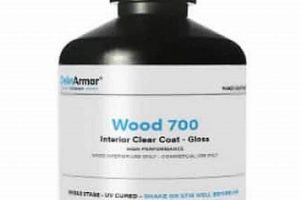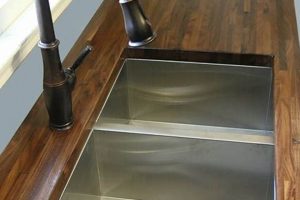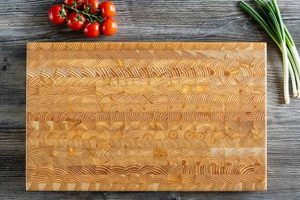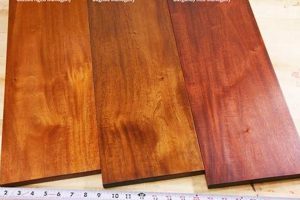This surface treatment is a process and a category of products designed to protect and beautify wooden surfaces. These products, typically available in various formulations like stains, sealants, and topcoats, enhance the wood’s natural grain while providing a protective barrier against moisture, scratches, and UV damage. For example, a craftsman might apply a penetrating stain to a bare wooden table, followed by a durable polyurethane topcoat to ensure longevity and resistance to everyday wear and tear.
Proper surface treatments offer significant advantages. They extend the lifespan of wooden items by preventing decay and damage from environmental factors. Historically, the application of oils and waxes was a rudimentary form of surface treatment, evolving over time with advancements in chemistry and manufacturing to yield more sophisticated and durable solutions. These modern solutions now provide enhanced color retention, scratch resistance, and ease of application.
Understanding the characteristics and application methods of different surface treatments is essential for achieving optimal results. The subsequent sections will delve into the selection criteria for choosing the appropriate treatment, preparing the wood surface, applying the chosen product, and maintaining the finished result for long-term aesthetic appeal and protection.
Application Guidance
The following are crucial considerations for maximizing the effectiveness of wood surface treatments and achieving professional-quality results.
Tip 1: Surface Preparation is Paramount: Thoroughly sand the wood surface, progressing through increasingly finer grits of sandpaper. Remove all dust and debris before proceeding. A smooth, clean surface ensures optimal adhesion and a uniform finish. For example, sanding to 220 grit is generally adequate for most interior projects.
Tip 2: Test the Product in an Inconspicuous Area: Always test the selected product on a scrap piece of the same wood or an inconspicuous area of the project. This step verifies the desired color and finish are achievable before applying it to the entire surface. Consider the impact of existing finishes as well.
Tip 3: Apply Thin, Even Coats: Avoid applying excessively thick coats, as this can lead to runs, drips, and uneven drying. Multiple thin coats are preferable to a single thick coat. Using a high-quality brush or applicator can significantly improve results.
Tip 4: Observe Drying Times: Adhere strictly to the manufacturer’s recommended drying times between coats and before applying any subsequent topcoats. Insufficient drying can compromise the durability and appearance of the finish.
Tip 5: Proper Ventilation is Essential: Ensure adequate ventilation during the application and drying process. This minimizes exposure to harmful vapors and promotes even drying. Consider using a respirator in enclosed spaces.
Tip 6: Stir, Do Not Shake: Prior to application, thoroughly stir the product to ensure uniform color and consistency. Shaking can introduce air bubbles that may affect the final finish.
Tip 7: Consider the Ambient Temperature and Humidity: Optimal application conditions typically involve moderate temperatures and low humidity. Extreme temperatures or high humidity can affect drying times and the overall quality of the finish.
Adhering to these guidelines will contribute to a durable, aesthetically pleasing, and long-lasting surface treatment.
The subsequent conclusion will summarize the critical aspects of this process, reinforcing the importance of careful planning and execution.
1. Surface Preparation
The quality of a surface treatment is inextricably linked to the effectiveness of surface preparation. Surface preparation is a critical component of successful wood finishing, directly influencing the adhesion, uniformity, and overall appearance of the final product. Inadequate preparation invariably leads to compromised results, regardless of the quality of the finish used. For example, if a wooden surface is not properly sanded, imperfections and unevenness will be accentuated by the stain, resulting in a blotchy and unprofessional appearance. Similarly, residual dust or contaminants on the surface can prevent the finish from bonding correctly, causing peeling or bubbling over time.
The impact of surface preparation extends beyond aesthetics to the protective qualities of the finish. A properly prepared surface allows the finish to penetrate the wood fibers, creating a stronger bond and enhancing its resistance to moisture, scratches, and UV damage. Conversely, a poorly prepared surface creates a barrier that inhibits penetration, reducing the finish’s ability to protect the wood from environmental factors. For instance, a polyurethane coating applied to an unsanded surface will be more susceptible to cracking and chipping compared to one applied to a smoothly sanded surface. This principle applies equally to interior and exterior projects; the longevity of the finish is directly proportional to the thoroughness of the preparation.
In summary, surface preparation is not merely a preliminary step but a foundational element of the entire wood finishing process. Neglecting this phase introduces a cascade of potential problems that undermine the effectiveness and longevity of the finish. Professionals and enthusiasts alike understand that achieving optimal results requires a commitment to meticulous surface preparation, as it is the cornerstone of a durable and visually appealing wood surface treatment. This understanding is not merely theoretical but demonstrable in the tangible differences between projects that prioritize preparation and those that do not.
2. Product Selection
Product selection is a pivotal determinant of success within the framework of wood surface treatments. The effectiveness of the chosen product, in terms of both aesthetics and protection, is contingent upon its suitability for the specific wood species, the intended use of the item, and the desired level of durability. Incorrect selection can lead to a variety of negative consequences, including inadequate protection, undesirable color or finish, and premature failure of the treated surface. For example, selecting an interior-grade stain for outdoor furniture will inevitably result in rapid degradation due to exposure to UV radiation and moisture, regardless of the quality of application. Similarly, applying a hard-wearing polyurethane finish to a flexible wood species might lead to cracking as the wood naturally expands and contracts.
The characteristics of the wood species itself significantly influence product selection. Dense hardwoods require different surface treatment products than softwoods due to variations in porosity and grain structure. A penetrating oil finish, for instance, might be ideal for enhancing the natural beauty of hardwoods like walnut or cherry, while a film-forming varnish may be more appropriate for protecting softer woods like pine from dents and scratches. The intended use of the wooden item also dictates product selection; a kitchen countertop requires a finish that is both water-resistant and food-safe, whereas a decorative picture frame might prioritize aesthetic appeal over heavy-duty protection. Therefore, a careful evaluation of the wood’s properties and the item’s purpose is paramount in making an informed decision.
In conclusion, product selection is not merely a matter of personal preference but rather a critical evaluation of the wood species, its intended use, and the desired protective qualities. Understanding the interactions between these factors enables informed decision-making, leading to optimal surface treatment outcomes. The potential pitfalls of incorrect product selection highlight the importance of careful consideration and informed decision-making in achieving durable and aesthetically pleasing results. Choosing the appropriate product provides the foundation for a long-lasting and visually appealing surface treatment, while a poor choice can compromise the entire project.
3. Application Technique
Application technique represents a critical determinant of the final appearance and durability of wood surface treatments. The method by which a product is applied directly impacts the uniformity, adhesion, and protective qualities of the resulting finish. Ineffective application can negate the benefits of even the highest-quality products, leading to aesthetic flaws, premature failure, and compromised protection of the wood surface.
- Brush Selection and Handling
The choice of brush, its material (natural or synthetic), and its size directly influence the application’s smoothness and evenness. Improper brush handling, such as applying excessive pressure or using an overloaded brush, can result in brush strokes, drips, and uneven coverage. For example, a high-quality natural bristle brush is often preferred for applying oil-based stains, while synthetic brushes are better suited for water-based finishes. Proper brush maintenance, including cleaning and storage, is essential for consistent application performance.
- Spraying Techniques and Equipment
Spraying provides a method for achieving a uniform, thin coat, especially on complex surfaces or when using quick-drying finishes. However, successful spraying requires proper equipment setup, including adjusting the nozzle for optimal atomization and maintaining consistent distance and speed. Insufficient atomization can lead to orange peel texture, while excessive overlap can cause runs and sags. Proper ventilation and personal protective equipment are essential when spraying.
- Wiping and Rag Application
Wiping is a common technique for applying penetrating stains and oils, allowing for controlled color saturation and easy removal of excess product. The choice of rag material, the amount of product applied, and the wiping technique all influence the final appearance. For example, using a lint-free cloth and wiping in the direction of the grain helps to achieve a uniform and streak-free finish. Leaving excess product on the surface can lead to a sticky or uneven appearance.
- Application Environment Control
The ambient temperature, humidity, and air circulation significantly impact drying times and the overall quality of the finish. Applying in excessively hot or humid conditions can cause the finish to dry too quickly, leading to blistering or cracking. Insufficient ventilation can trap solvent vapors, prolonging drying times and increasing the risk of fire or health hazards. Maintaining a clean and dust-free environment minimizes contamination of the wet finish.
These facets of application technique, when executed with precision and care, contribute significantly to the success of surface treatment projects. Attention to detail in brush selection, spraying techniques, wiping methods, and environmental control enables the achievement of a durable, aesthetically pleasing, and long-lasting finish. Neglecting these elements can result in compromised outcomes, underscoring the crucial role of proper application technique.
4. Drying Time
Drying time is a critical and often underestimated component within the framework of wood surface treatments. Insufficient attention to drying time can significantly compromise the durability, appearance, and protective qualities of any wood finish. This parameter dictates the period required for solvents and other volatile components within a wood finishing product to evaporate fully, allowing the applied finish to cure and harden. When dealing with products, adhering to the manufacturer’s specified drying times is paramount to prevent issues like tackiness, wrinkling, or incomplete film formation. For example, if a polyurethane topcoat is recoated before it has fully dried, the subsequent layer may trap solvents, leading to a soft, easily damaged surface. Similarly, premature use of a stained and sealed wooden surface can result in imprints, scratches, or staining of the finished surface.
The relationship between environmental conditions and drying time is also a factor. Higher humidity levels can prolong the evaporation of solvents, extending the drying time and potentially impacting the final finish. Conversely, excessively high temperatures can cause the finish to dry too rapidly, leading to cracking or blistering. In practical applications, understanding these variables allows for adjustments in the application process. For instance, during periods of high humidity, it may be necessary to extend the drying time beyond the manufacturer’s recommendations. Furthermore, utilizing fans or dehumidifiers can accelerate the drying process in enclosed spaces, but care must be taken to ensure even air circulation to prevent uneven drying.
In conclusion, the management of drying time is integral to achieving optimal results in wood surface treatments. A comprehensive understanding of factors affecting drying time, including product characteristics and environmental conditions, is essential. The challenges associated with improper drying, such as compromised durability and aesthetic imperfections, underscore the importance of meticulous adherence to recommended drying times and proactive adjustments based on prevailing environmental factors. Prioritizing this aspect is crucial for realizing the full potential of the surface treatment process and ensuring the longevity and beauty of the finished wood project.
5. Environmental Factors
Environmental factors exert a significant influence on the application and performance of wood surface treatments. Temperature, humidity, and air quality directly affect the viscosity of the finish, the evaporation rate of solvents, and the curing process. Deviations from optimal conditions can lead to a range of adverse outcomes, compromising the aesthetics and durability of the final result. For instance, the application of a polyurethane finish in excessively humid conditions may result in a cloudy or milky appearance, as moisture becomes trapped within the drying film. Similarly, high temperatures can cause the finish to dry too rapidly, leading to blistering or cracking. Airborne contaminants, such as dust or pollen, can also mar the finish’s surface, requiring additional sanding and recoating.
The impact of environmental factors extends beyond the immediate application process. Long-term exposure to ultraviolet (UV) radiation, moisture, and fluctuating temperatures can accelerate the degradation of wood finishes, leading to fading, cracking, and peeling. Exterior applications are particularly vulnerable, necessitating the use of UV-resistant finishes and regular maintenance to preserve their protective qualities. The selection of a finish with appropriate weather resistance characteristics is critical for ensuring longevity in outdoor environments. A penetrating oil finish, while enhancing the natural beauty of wood, may offer limited protection against moisture and UV damage, requiring more frequent reapplication compared to a more robust film-forming finish. Practical significance of this understanding is observed through reduced maintenance and repair costs, alongside extended lifespan of wood elements within structures.
Effective management of environmental factors is essential for achieving optimal results. This includes selecting appropriate application times, controlling temperature and humidity levels within the work environment, and implementing measures to minimize airborne contaminants. Understanding the specific vulnerabilities of different finishes to environmental stressors allows for proactive selection of products and maintenance strategies. In conclusion, the interplay between environmental factors and surface treatments underscores the importance of a holistic approach to wood finishing, considering both the immediate application environment and the long-term exposure conditions to ensure durable and aesthetically pleasing results.
6. Protective Qualities
The protective qualities inherent in wood surface treatments are paramount to safeguarding wooden substrates from a range of environmental and mechanical stresses. These qualities are directly related to the formulation and application of products designed for enhancing the durability and longevity of wood, ensuring it resists degradation and maintains its aesthetic appeal over time.
- Moisture Resistance
Moisture resistance is a critical protective quality, preventing water absorption that can lead to swelling, warping, and decay. Surface treatments create a barrier that inhibits moisture penetration. For example, the application of a water-resistant sealant on wooden furniture exposed to outdoor elements minimizes water damage. Poor moisture resistance can result in structural weakening and fungal growth within the wood fibers.
- Scratch and Abrasion Resistance
Scratch and abrasion resistance protects the wood surface from physical damage caused by daily use and contact with other objects. This quality is particularly important for surfaces subjected to heavy traffic. The application of a durable topcoat, such as polyurethane, provides a hard, protective layer that withstands scuffs and scratches. Insufficient abrasion resistance leads to surface wear and detracts from the aesthetic appearance of the wood.
- UV Protection
UV protection shields the wood from the harmful effects of ultraviolet radiation, which can cause fading, discoloration, and degradation of the wood’s surface. This quality is essential for outdoor applications where prolonged sun exposure is inevitable. Finishes containing UV absorbers or stabilizers mitigate the damage caused by UV radiation, preserving the wood’s color and structural integrity. Without UV protection, wood can become brittle and develop unsightly discoloration.
- Chemical Resistance
Chemical resistance safeguards the wood from damage caused by exposure to various chemicals, such as household cleaners, solvents, and acids. This protective quality is crucial for surfaces in kitchens, laboratories, and other environments where chemical spills are likely to occur. Finishes formulated with chemical-resistant properties prevent staining, etching, and other forms of chemical damage. Inadequate chemical resistance can result in permanent blemishes and degradation of the wood surface.
These interconnected protective qualities collectively contribute to the overall effectiveness in preserving and enhancing wooden surfaces. The appropriate selection and application, tailored to the specific environmental conditions and intended use of the wood, are essential for maximizing these protective benefits and ensuring the long-term preservation of wooden structures and items.
7. Longevity
The extended lifespan of wooden surfaces is a primary objective in the application of surface treatments. Longevity, in the context of these treatments, signifies the ability of a finish to maintain its protective and aesthetic properties over an extended period, resisting degradation from environmental and mechanical stresses. The effectiveness of a wood finishing product in achieving longevity depends on several interconnected factors.
- Formulation and Composition
The chemical composition of a wood finishing product directly affects its durability and resistance to degradation. Products formulated with high-quality resins, UV absorbers, and stabilizers offer superior protection against moisture, sunlight, and chemical exposure, thereby extending the lifespan of the treated surface. For instance, a marine-grade varnish, designed for harsh marine environments, exhibits greater longevity compared to a standard interior varnish when exposed to the elements. The specific blend of ingredients determines the product’s ability to withstand environmental stressors and maintain its protective properties.
- Adhesion and Penetration
The ability of a wood finish to properly adhere to the wood substrate and penetrate its surface is crucial for long-term performance. Proper adhesion prevents peeling, cracking, and blistering, while adequate penetration ensures that the finish bonds securely with the wood fibers, creating a durable and resilient barrier. A poorly adhering finish is more susceptible to damage and degradation, significantly reducing its lifespan. Surface preparation techniques, such as sanding and cleaning, play a vital role in promoting adhesion and penetration, ultimately contributing to the finish’s longevity.
- Maintenance and Care
Regular maintenance and proper care are essential for prolonging the lifespan of wood finishes. Cleaning, reapplication of protective coatings, and prompt repair of damaged areas help to preserve the finish’s protective qualities and prevent further degradation. For example, regular cleaning with a mild detergent removes dirt and grime that can dull the finish and accelerate wear. Periodic application of a maintenance coat replenishes the protective barrier, extending the time between more extensive refinishing projects. Neglecting maintenance can significantly shorten the lifespan of the finish and compromise its ability to protect the wood.
- Environmental Exposure
The environmental conditions to which a wood finish is exposed directly influence its longevity. Surfaces exposed to harsh sunlight, moisture, and temperature fluctuations require more robust and durable finishes to withstand these stressors. Interior finishes, sheltered from the elements, generally exhibit greater longevity compared to exterior finishes. Selecting a finish appropriate for the specific environmental conditions and implementing protective measures, such as shading or covering exposed surfaces, can significantly extend the lifespan of the treated wood.
These facets are interconnected in determining the overall longevity of the treatments. The interplay between product formulation, application techniques, maintenance practices, and environmental conditions dictates how well a finish will endure over time. Therefore, a comprehensive approach that addresses each of these factors is essential for maximizing the lifespan and preserving the beauty of treated wood surfaces.
Frequently Asked Questions Regarding Wood Surface Treatment
The following addresses common inquiries concerning the application, maintenance, and performance of wood surface treatments. Understanding these points is crucial for achieving optimal results and ensuring the longevity of finished wood surfaces.
Question 1: How does one properly prepare a wood surface prior to applying a finish?
Surface preparation typically involves sanding the wood to a smooth, uniform texture, starting with coarser grits and progressing to finer grits. The surface must then be thoroughly cleaned to remove any dust, debris, or contaminants that may impede adhesion. Depending on the wood species and the desired finish, additional steps such as applying a wood conditioner or stain may be necessary.
Question 2: What factors should be considered when selecting a wood finish for a specific project?
Selection criteria should include the type of wood, the intended use of the item, the desired level of protection, and aesthetic preferences. Exterior applications require finishes with UV resistance and moisture protection, while interior applications may prioritize aesthetics and durability. The chemical composition of the finish, its ease of application, and its maintenance requirements should also be considered.
Question 3: What are the common mistakes to avoid when applying a wood finish?
Common errors include inadequate surface preparation, applying the finish too thickly, neglecting drying times, and failing to provide proper ventilation. Over-application can lead to runs, drips, and uneven drying, while insufficient ventilation can prolong drying times and create health hazards. Ignoring manufacturer’s instructions can also compromise the quality of the finish.
Question 4: How can one properly maintain a wood finish to ensure its longevity?
Maintenance typically involves regular cleaning with mild detergents, avoiding harsh chemicals or abrasive cleaners. Periodic reapplication of a maintenance coat, such as wax or polish, can help to replenish the protective barrier and extend the lifespan of the finish. Promptly addressing any scratches, dents, or water damage can prevent further deterioration of the wood surface.
Question 5: What are the indications that a wood finish needs to be reapplied or refinished?
Signs that a finish requires attention include fading, cracking, peeling, or discoloration. Excessive wear, scratches, or water damage can also indicate that the protective barrier has been compromised. If the finish no longer provides adequate protection or aesthetic appeal, reapplication or refinishing may be necessary.
Question 6: How do environmental factors influence the performance of wood finishes?
Temperature, humidity, and sunlight can significantly impact the durability and longevity of wood finishes. High humidity can prolong drying times and promote mildew growth, while excessive sunlight can cause fading and cracking. Fluctuations in temperature can lead to expansion and contraction of the wood, potentially causing the finish to peel or crack. Choosing finishes appropriate for the specific environmental conditions and implementing protective measures can mitigate these effects.
The preceding FAQs address essential considerations regarding surface treatments. Understanding these points is crucial for realizing the full potential of the process and ensuring lasting results.
The subsequent section will delve into specific product recommendations and their applications.
Conclusion
This exposition has detailed the multifaceted nature of wood surface treatments, from surface preparation and product selection to application techniques, drying times, and the influence of environmental factors. The protective qualities and longevity of such treatments have been emphasized, underscoring the importance of a comprehensive understanding of each component. Neglecting any aspect of the process carries the risk of compromised results, diminished protection, and reduced lifespan of the treated wood.
The enduring value of wood as a construction material and an aesthetic element mandates informed decisions regarding its preservation. Therefore, a commitment to rigorous preparation, informed product choices, meticulous application, and diligent maintenance is not merely advisable but essential. The responsible application of this knowledge ensures the continued beauty, structural integrity, and long-term sustainability of wooden surfaces for generations to come.


![Guide: How to Finish Cedar Wood [Tips & Tricks] Best Final Touch: Elevate Your Projects with Professional Finishing Guide: How to Finish Cedar Wood [Tips & Tricks] | Best Final Touch: Elevate Your Projects with Professional Finishing](https://bestfinaltouch.com/wp-content/uploads/2025/10/th-953-300x200.jpg)




